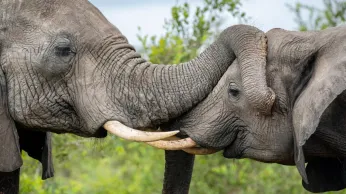
4 hours ago
Sri Lankan Wildlife Officers Document Same-Sex Bonding Among Elephants
READ TIME: 3 MIN.
Wildlife officers in Colombo, Sri Lanka, have recently documented male elephants exhibiting same-sex behaviors, including bonding rituals and mounting, in two of the country’s prominent national parks. The observations, made in Minneriya and Kaudulla National Parks, have drawn attention from both the scientific community and LGBTQ+ advocates, providing new insight into the complexity and diversity of animal behavior .
According to Sri Lanka’s English-language Daily Mirror, wildlife officers described the behavior as a “natural part of elephant social behaviour” and noted that such acts are particularly observed during times of resource abundance, when food and water are readily available in the parks . These interactions include physical displays such as mounting and other affectionate contact between male elephants.
While same-sex interactions among animals have been documented in various species—including whales, penguins, sheep, and flamingos—the findings from Sri Lanka’s elephant population are notable for their visibility and for the context in which they were observed . Wildlife officers reported that male elephants who are not able to compete with physically stronger bulls for mating opportunities with females may instead form close bonds with other males, including displays of affection and mounting. However, researchers emphasize that these behaviors are not merely compensatory, but form part of the broader spectrum of natural elephant social structures .
Behavioral ecologists have long observed same-sex interactions in a wide array of animals, challenging the misconception that heterosexuality is the only “natural” orientation in nature. Such observations have been documented in scientific literature for decades, showing that animal societies often include a diverse range of sexual and social relationships .
For LGBTQ+ advocates and scientists alike, the documentation of same-sex bonding in elephants provides valuable opportunities to foster inclusivity in both scientific discourse and public understanding. The visibility of same-sex behavior in one of the world’s most iconic animal species serves to counter persistent myths about the “unnaturalness” of homosexuality, both in animals and in humans . As Dr. Anjali Perera, a Sri Lankan conservation biologist, explains, “The more we learn about the diversity of behavior in wildlife, the more we understand that same-sex bonds are a natural and integral part of many animal communities. It’s essential that our science reflects the full spectrum of animal experiences.”
Internationally, LGBTQ+ organizations have often highlighted such findings to promote acceptance and challenge prejudice. By recognizing same-sex behavior in animals, advocates hope to reduce stigma and misinformation about LGBTQ+ people. These scientific insights underscore the need for inclusive education and representation in all areas of society .
While Sri Lanka retains colonial-era laws prohibiting same-sex relationships, recent years have seen growing acceptance of LGBTQ+ visitors, especially in urban and tourist centers such as Colombo. The Supreme Court has ruled that anti-LGBTQ+ laws are unenforceable, and the country’s tourism sector is increasingly welcoming to LGBTQ+ travelers . Wildlife tourism, including elephant safaris in parks like Minneriya, Kaudulla, and Udawalawe, plays a significant role in the country’s economy and offers unique opportunities for visitors to witness Sri Lanka’s rich biodiversity—including, now, the natural diversity within animal societies.
Wildlife conservation organizations operating in Sri Lanka, such as The Great Elephant Project and Volunteer World, emphasize the importance of respecting animal behaviors and supporting inclusive research that documents the full range of elephant social life .
The recent observations from Sri Lanka’s national parks contribute to a growing body of evidence that same-sex behavior is a widespread and natural phenomenon in the animal kingdom. For both scientists and LGBTQ+ communities, these findings offer a reminder that diversity—whether in animal societies or human ones—is something to be studied, respected, and celebrated .
As public awareness grows and societal attitudes shift, the documentation of same-sex bonding among elephants stands as a symbol of the natural world’s diversity—and an invitation to embrace inclusivity in all aspects of life.






